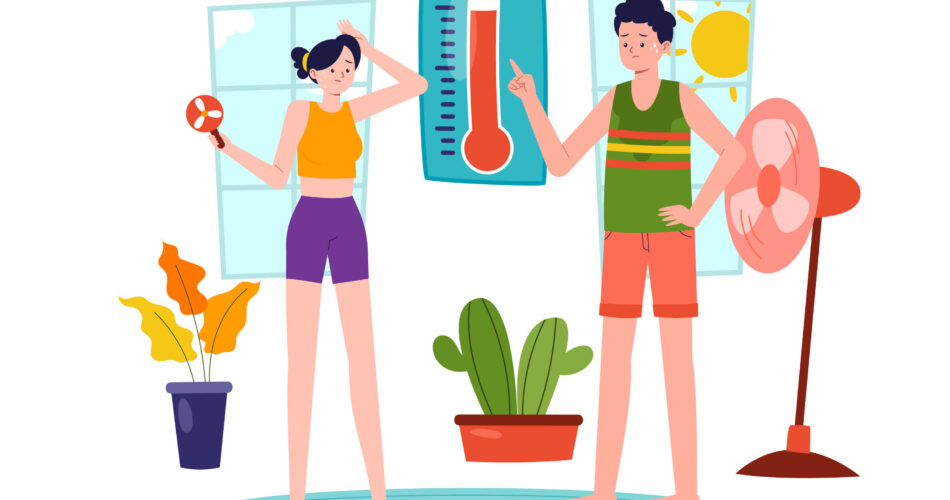The heat is on, signaling the chance to enjoy summer in the Philippines. However, during the past few days, weather forecasts have revealed a tremendous heat index in several places, making people at risk of heat stroke.
Recently, a scorching heat temperature of 42°C to 51°C was recorded across the nation in the beginning of April, which led to the postponement of classes for many schools. Due to too much heat, the welfare of children is at stake. Although, children are not the only people at risk of this heat as everyone can experience severe exhaustion from heat exposure. That’s why it is best to be knowledgeable about what to do in such scenarios, especially as it can lead people to suffer from heat stroke.
Find out how you can protect yourself and avoid the impending health risks caused by high temperatures this summer. Let’s begin by dwelling more about the possible health tips in this blog today!
Understanding Heat Stroke

Heat stroke is a condition in which the body’s core temperature rises to dangerous levels due to prolonged exposure to high temperatures. It is considered a medical emergency and can lead to serious complications or even death if not treated promptly. This condition typically occurs as a progression from milder heat-related illnesses such as heat cramps, heat exhaustion, and heat syncope.
The body has a natural mechanism to regulate its temperature through sweating. However, in extreme heat or when the body is unable to cool itself effectively, the core body temperature can rise rapidly. This can be exacerbated by dehydration, which impairs the body’s ability to sweat and cool down.
It is important to note that this condition can affect anyone, but certain individuals are more susceptible, such as older adults, young children, and those with pre-existing medical conditions like high blood pressure or diabetes. Additionally, working or exercising in hot and humid environments for prolonged periods increases the risk of heat stroke.
Age Groups at Risk
As mentioned, there’s a wide range of age groups when it comes to patients that commonly suffer from heat stroke. Despite affecting all ages, certain age groups are more vulnerable such as infants and children up to age 4. At the same time, adults over the age of 65 are particularly at risk because they may have difficulty adjusting to heat more slowly than others. It is important to take extra precautions to protect these age groups.

Protecting Vulnerable Age Groups
Protecting vulnerable age groups requires taking immediate medical treatment, extra precautions, and adjusting outdoor activities accordingly. Here are some ways to protect vulnerable age groups:
- Ensure proper hydration by encouraging regular drinking of water or other hydrating fluids.
- Provide a cool and shaded environment, especially during the hottest parts of the day.
- Dress young children and elderly individuals in lightweight, loose-fitting, and light-colored clothing to help regulate body temperature.
- Limit outdoor activities, especially during high temperatures, and encourage indoor activities or activities in shaded areas.
It is important to be vigilant and monitor the well-being of young children and elderly individuals during hot weather. If any signs or symptoms are observed, seek immediate medical attention.
Symptoms of Heat Stroke

Recognizing the symptoms of heat stroke is essential for prompt medical intervention. The hallmark symptom of this condition is a core body temperature above 104°F (40°C). This high temperature can lead to various complications in the body. Other symptoms of heat stroke include:
- Throbbing headache
- Dizziness and light-headedness
- Lack of sweating despite the heat
- Red, hot, and dry skin
- Muscle weakness or cramps
- Nausea and vomiting
- Rapid heartbeat
- Rapid, shallow breathing
- Behavioral changes such as confusion or disorientation
- Seizures
- Unconsciousness
These symptoms can vary from person to person, and not all symptoms may be present in every case of heat stroke. However, the presence of a high body temperature and other symptoms should be taken seriously, as heat stroke can be life-threatening. When experiencing symptoms of heat stroke, it is important to seek immediate medical attention.
The Importance of Immediate Medical Attention
When this condition occurs, it is considered a medical emergency, which means the patient requires immediate medical attention. Delaying treatment can lead to serious complications and even death.
Heat stroke can cause damage to the brain, heart, kidneys, and muscles, and the longer treatment is delayed, the greater the risk of complications. Seeking immediate medical attention ensures that proper medical care can be provided to stabilize the individual’s condition and prevent further harm.
If you suspect someone is experiencing such complication, call for emergency medical assistance right away. Every minute counts when it comes to this illness, and prompt medical attention can make a significant difference in the outcome.
When to Visit an Emergency Room

Heat stroke can quickly lead to organ damage and even death if left untreated. If you or someone you know is experiencing the mentioned symptoms above, it might be time to visit the nearest local health center for an emergency check up. It is crucial to call for emergency medical assistance and provide first aid measures, such as moving to a cooler location and applying cool water or ice packs to the body, while waiting for medical help to arrive.
A Beginner’s Guide to Heat Stroke Prevention
Prevention is key when it comes to heat stroke. Taking proactive measures to prevent it can help keep you safe and avoid the risk of complications. Here is a beginner’s guide for prevention:
- Stay hydrated
- Limit physical activity
- Dress appropriately
- Be aware of the heat index
- Seek shade or air-conditioned environments
Remember, heat stroke can still be preventable despite its potential risk to the patient’s life when not treated immediately. By following these simple guidelines and being mindful of the heat, you can protect yourself and stay safe during periods of extreme heat.

First Aid Tips
Knowing how to administer first aid for heat stroke can be crucial in managing the condition and preventing further complications. Here are some first aid measures to consider for heat stroke:
- Move to a cooler area: If possible, move the person experiencing heat stroke to a shaded or air-conditioned location.
- Apply cool water or wet towels: Wet towels or cool water can be applied to the body to help lower the core temperature. Focus on areas with a high concentration of blood vessels, such as the armpits, groin, neck, and back.
- Use ice packs: Place ice packs or cold compresses on the person’s neck, armpits, and groin. Cooling these areas can help lower body temperature.
- Encourage drinking fluids: If the person is conscious and able to drink, provide them with cool water or a sports drink to help rehydrate their body.
- Seek medical assistance: Heat stroke is a medical emergency, and it is important to seek professional medical help as soon as possible. Call emergency services or take the person to the nearest hospital for immediate medical attention.
Remember to prioritize safety and seek professional medical help when dealing with heat stroke. First aid measures can provide temporary relief, but medical intervention is crucial for proper treatment and prevention of complications.
Frequently Asked Questions
What is the first thing to do if someone has a heat stroke?
If someone is experiencing symptoms of heat stroke, immediate action is necessary. Move the person to a cooler location, provide cold water or wet towels to help lower body temperature. Most of all, it is essential to seek medical help immediately.
How long does it take to recover from heat stroke?
Recovery time from heat stroke can vary depending on the severity of the condition and individual factors. With proper medical care and rest, most people recover fully within a few days to a week. However, individuals with underlying health conditions or prolonged heat stress may require a longer recovery period.
Conclusion
Recognizing the signs of heat stroke is crucial in protecting yourself and your loved ones. By staying informed and practicing heat stroke prevention techniques, you can reduce the risk of heat-related illnesses. Remember, quick action saves lives, so always be prepared to offer first aid and know when to seek professional medical care.
Get to know more about what to do when dealing with heat stroke. Book an online consultation with your family doctor or visit a local health center for a check up.
